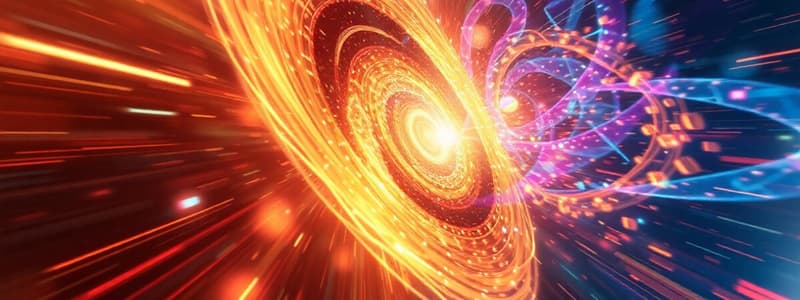Podcast
Questions and Answers
According to Newton's First Law, what condition is required for an object to maintain a constant velocity?
According to Newton's First Law, what condition is required for an object to maintain a constant velocity?
- No external force acts on the object. (correct)
- The object must be accelerating.
- An external force must be acting on the object.
- The object must be at rest.
Which of the following statements best describes Newton's Third Law of Motion?
Which of the following statements best describes Newton's Third Law of Motion?
- Forces are the product of mass and acceleration.
- An object at rest stays at rest unless acted upon by a force.
- A force applied to an object results in acceleration.
- For every action, there is an equal and opposite reaction. (correct)
If an object is moving in a circle at a constant speed, its velocity is also constant.
If an object is moving in a circle at a constant speed, its velocity is also constant.
False (B)
An object is being acted upon by multiple forces. According to the principles of dynamics, what determines the net force acting on the object?
An object is being acted upon by multiple forces. According to the principles of dynamics, what determines the net force acting on the object?
If a 2 kg mass accelerates at 3 m/s², what is the net force acting on it, according to Newton's Second Law?
If a 2 kg mass accelerates at 3 m/s², what is the net force acting on it, according to Newton's Second Law?
The force that causes an object to move in a circle is called ______ force.
The force that causes an object to move in a circle is called ______ force.
Match the following terms with their description:
Match the following terms with their description:
What is the relationship between mass and weight?
What is the relationship between mass and weight?
A car drives around a banked curve. Which force or forces provide the centripetal force that allows the car to turn?
A car drives around a banked curve. Which force or forces provide the centripetal force that allows the car to turn?
A 5 kg object is moving in a circle with a radius of 2 meters at a speed of 4 m/s. Calculate the centripetal force acting on the object.
A 5 kg object is moving in a circle with a radius of 2 meters at a speed of 4 m/s. Calculate the centripetal force acting on the object.
Flashcards
Newton's First Law
Newton's First Law
An object continues at rest or constant velocity unless acted upon by an external force.
Newton's Second Law
Newton's Second Law
An external force gives an object an acceleration proportional to the force. F=ma
Newton's Third Law
Newton's Third Law
Forces come in symmetric pairs, equal in magnitude and opposite in direction.
Forces are Vectors
Forces are Vectors
Signup and view all the flashcards
Weight
Weight
Signup and view all the flashcards
Centripetal Force
Centripetal Force
Signup and view all the flashcards
Centripetal Acceleration
Centripetal Acceleration
Signup and view all the flashcards
Normal Force
Normal Force
Signup and view all the flashcards
Study Notes
Dynamics - Learning Goals
- Newton’s Laws of Motion define force.
- Kinematic concepts relate to Newton’s 2nd Law.
- Defines weight and mass.
- Explains the vector character of forces.
- Examines force as interaction using Newton’s 3rd Law.
- Explores forces acting on surfaces, including normal force.
- Discusses motion in a circle, including velocity, centripetal acceleration, and force.
Newton's First Law
- An object remains at rest or in constant velocity unless acted upon by an external force.
- Constant velocity implies constant speed in a straight line.
Newton's Second Law
- An external force applied to an object results in an acceleration proportional to the force, defined as F = ma where F is force, m is mass, and a is acceleration.
Newton's Third Law
- Forces occur in symmetric pairs, equal in magnitude and opposite in direction.
Units of Force
- The unit of force is the Newton (N).
- One Newton is required to accelerate a 1 kg mass at 1 m/s².
Weight and Mass Defined
- Any object of mass (m) falling with the acceleration of gravity (g) is acted on by a force of F = mg.
- The downward force due to gravity is called weight (W=mg), measured in Newtons.
- A 1 kg mass has a weight of about 10 N, and a 20 kg mass has a weight of about 200 N.
Forces as Vectors
- Forces possess both magnitude and direction.
- They are added by the parallelogram rule.
- Any force (F) is the vector sum of two suitable forces.
- Fx and Fy are components of F, having the same effect when acting together.
Components of a Force Example
- If a force, F = 10.0 N, is directed at 30° from the vertical, its vertical and horizontal components can be calculated.
Newton's Third Law in Action
- Forces occur in symmetric pairs, equal in magnitude and opposite in direction.
- For every action, there is an equal and opposite reaction.
- Example: Action is force applied by object 1 on object 2, accelerating object 2.
- Reaction is force applied by object 2 on object 1, accelerating object 1.
The Normal Force
- Flower pot on table demonstrates Newton's First Law, where the net vertical force is zero (N = W = mg).
- The force is due to the deformation of the table surface.
- If m = 30 kg then, N = W = 300 N
Motion in a Circle - Speed
- Time to complete one full rotation is the period (T).
- Distance to fully rotate is 2πr.
- Hence speed (v) = 2πr/T
- Example: if r = 2 m, T = 3 s, then v = 4.2 m/s
Motion in a Circle - Velocity
- Even with constant speed, the velocity of an object moving in a circle changes because its direction changes.
- Acceleration is directed towards the circle's center.
Centripetal Acceleration
- The magnitude of centripetal acceleration is: a = v²/r
- Centripetal acceleration can be written in terms of the period of motion around a circle: a = 4π²r / T²
Centripetal Force
- Centripetal acceleration implies there must be a centripetal force: F = mv²/r
- This force is required whenever an object moves in a circle at constant speed.
Sources of Centripetal Force
- Friction
- Normal force
- Tension in a string
- Gravitation
Studying That Suits You
Use AI to generate personalized quizzes and flashcards to suit your learning preferences.




